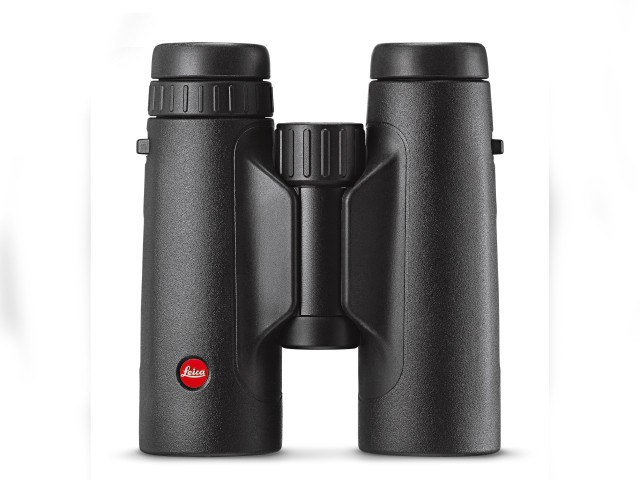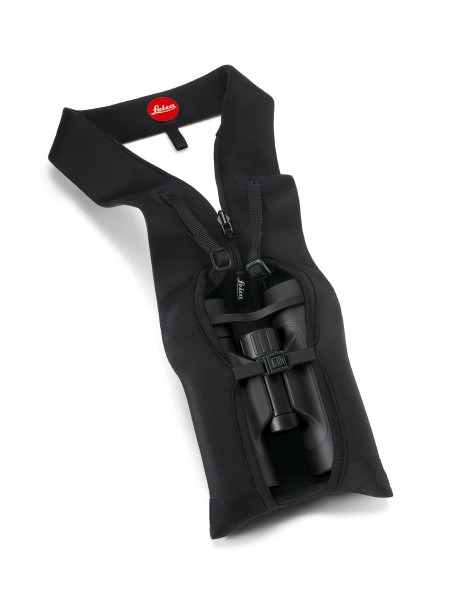Leica Trinovid 10×42 HD binocular
Leica's latest offering builds on a name that has been synonymous with the quality of the brand for many years. The new Trinovids are available in two 42 mm specifications — 8× and 10× magnification — and have been redesigned and attractively priced with a view to widening the appeal of the brand to birders.
I generally opt for 10× magnification binoculars, preferring the extra 'reach' they provide in preference to the increased light-gathering capacity of the lower magnification, so I chose the 10×42 Trinovids to test in the field.
For a 42 mm binocular, it is relatively compact and sits perfectly balanced in the hand. There is no contouring of the rubber armour, which is smooth but textured enough to provide a relatively non-slip surface. There are also no cutaway thumb-rests. Despite this apparent lack of detail, the Trinovids appear anything but plain, with the central hinge surrounded by a loop of low friction rubber, the model name and specification inset boldly in silver along the right-hand side of the chassis and the familiar Leica logo shallowly recessed into the front of the body, just above the right objective.
The armour is nicely finished around the objectives, adhering firmly to the body. All too frequently in many binoculars it is possible to pull back the rubber to partly expose the metal housing in this area. Pleasingly, this does not occur with the Trinovid.

The chassis itself is lightweight magnesium and, at 720 g, the overall weight is just a little below that of the flagship Ultravid HD-Plus and little more than 90 per cent of the model the new Trinovid replaces. The weight is not the only thing which is reduced, though, as the price is nearly £350 lower, too.
Super-smooth mechanics are employed in the focusing mechanism, with the non-slip, rubber-clad central wheel turning through two full clockwise rotations between the 1.6 m close focus and infinity. This may at first appear 'slow' if you need to quickly lock on to a distantly flying bird while observing a subject at close quarters but, realistically, it takes just a 90-degree turn to cover the range between the two.
The single-eye adjustment is mounted on the right ocular and it, too, turns very smoothly — a little too smoothly, if I'm honest. While there is an incremental scale, there is no means of locking the desired setting and I found the dioptre ring prone to accidental movement in the field, although it wasn't a frequent occurrence.
Fortunately, the same cannot be said for the eyecups, which click-lock solidly in place in four positions above the base setting. Although the articulated rainguard supplied with the Trinovid is tight fitting, I found it does not dislodge the eyecups from any of these positions when used in wet conditions. At the most extended position I was still able to see the full field of view. The rims of the eyecups are cushioned in very soft, deep rubber, which is comfortable against the eye during prolonged periods of viewing.
The image is excellent: bright and sharp with superb colour fidelity. The sharpness extends almost to the very edges of the field and there is a pleasing degree of contrast. In poor light conditions the Trinovid continued to return a satisfyingly bright image, reflecting the fact that the lenses are fully multicoated and made from ED glass.
This glass is a different grade from that which is used in the Ultravid, accounting for the price differential. It may also account for the level of chromatic aberration evident in the image. Watching Common Swifts against a grey, though bright, sky for instance highlighted a greater degree of colour fringing in the centre of the image than I would have expected, but in all other viewing conditions this was largely unnoticeable.
As is the case with the other top models in the Leica range, the Trinovid's lenses feature water-resistant and dirt-repellent coatings. Additional protection is afforded both by the aforementioned rainguard — which is a little too deep and does not pull off quickly — and a new innovation, the 'adventure strap' (pictured above).
This can be used in place of a conventional neck-strap (also supplied) and doubles as a harness and flexible protective case. The 'body' of the case is a neoprene material with a central zip, which can be used to wholly cover and protect the binocular while still being worn. It is worn via a comfortably padded neck-strap and secured around the waist with a further strap which is quickly detachable when desired. In addition to the protection factor it also serves to secure the Trinovid and stop it swinging around.
I'm usually no fan of harnesses — I find them somewhat restrictive — but the detachable strap makes this one very easy to wear and remove. When the binocular is enclosed, however, the zip may slow down your ability to react quickly to a passing bird in the field.

The Trinovid is a sturdy, solidly built, quality product which is no less than I would expect from Leica, offering a less costly alternative to their top-tier HD-Plus range. It's clearly worthy of further investigation by anyone who is considering investing less than £1,000 in a new binocular.
Further info
- Price: £875
- Size: 117×140 mm
- Weight: 720 g
- Field of view: 113 m at 1,000 m
- Light transmission: 90 per cent
- Close focus: 1.6 m
- Gas-filled: yes
- Waterproof: yes
- Guarantee: 10 years



